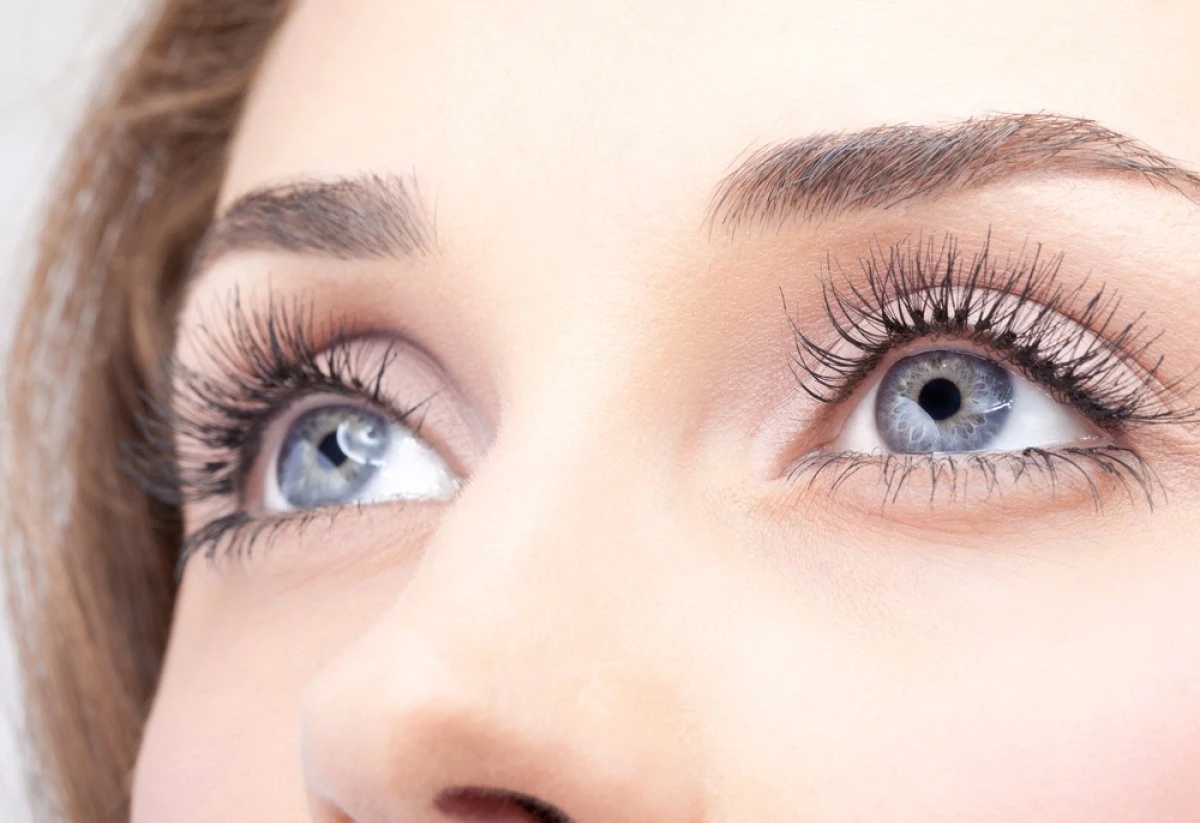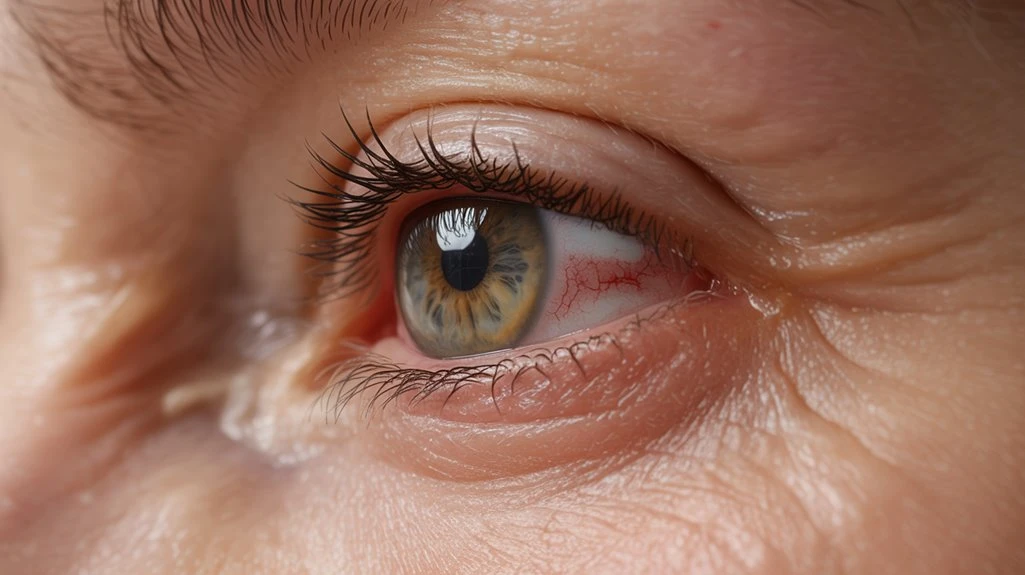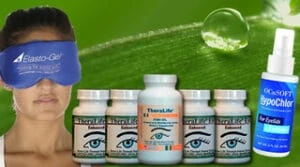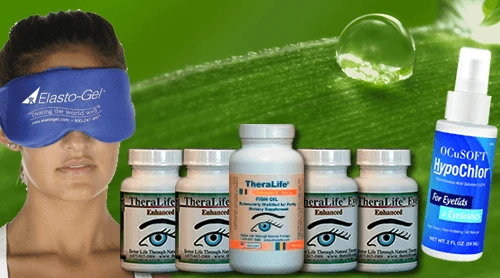When dealing with ocular rosacea, individuals often experience chronic eye redness, a burning sensation, and a persistent feeling of grittiness. Theralife’s unique approach offers comprehensive relief through its exclusive oral eye treatment care. Theralife is the only company providing this innovative method, which targets symptoms such as visible blood vessels on eyelid margins, dryness, and stinging.
Theralife’s products benefit customers by addressing sensitivity to light and eyelid inflammation, including swelling, crusting, or thickening. The oral treatment can help prevent potential complications like blurred vision or corneal issues, offering a holistic solution to this challenging condition. Recognizing these symptoms and opting for Theralife’s specialized care is crucial to effectively managing ocular rosacea.
Powerful Ocular Rosacea Relief With TheraLife
Chronic dry eye is a significant feature of ocular rosacea.
Treating dry eyes will reduce inflammation and keep ocular rosacea under control
Key Takeaways
- Persistent eye redness and visible blood vessels on the white of the eye are common in ocular rosacea.
- Burning, stinging, dryness, and a gritty or sandy sensation often affect the eyes and eyelids.
- Chronic eyelid inflammation (blepharitis) leads to crusting, irritation, and sometimes swollen or thickened eyelid margins.
- Light sensitivity (photophobia) and increased blinking or squinting can occur due to ocular surface inflammation.
- Flare-ups are triggered by wind, sunlight, cosmetic products, or certain foods, worsening eye discomfort and redness.
Common Signs of Ocular Rosacea
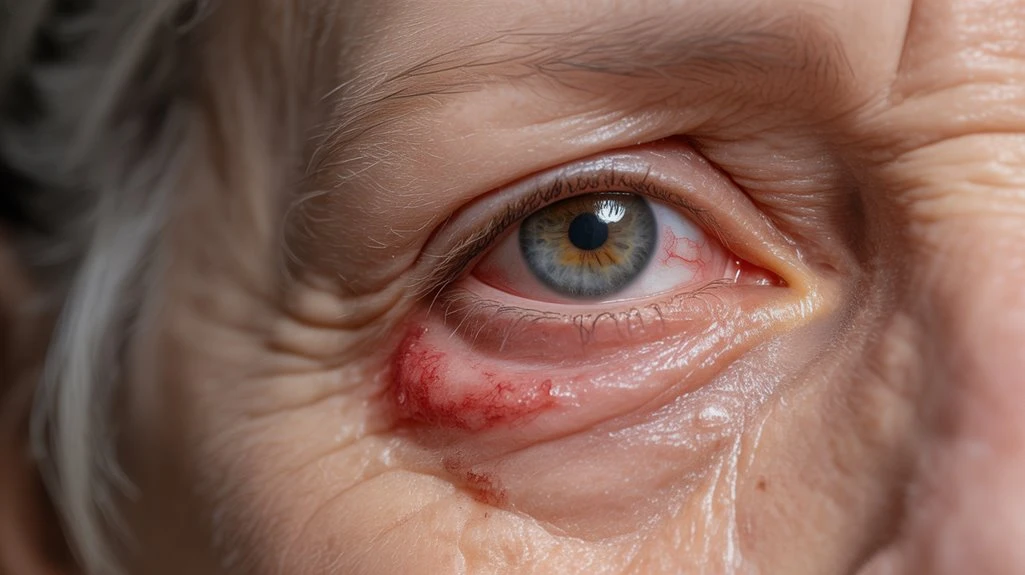
Several key symptoms can help clinicians identify ocular rosacea in patients. You may report sensations of burning, stinging, or foreign body presence in the eyes.
Chronic eyelid margin inflammation, or blepharitis, frequently co-occurs, leading to crusting, irritation, and meibomian gland dysfunction. Patients often experience fluctuating vision or increased photosensitivity due to tear film instability.
Dry eye symptoms, such as grittiness and ocular discomfort, are common, and conjunctival irritation may present as persistent discomfort rather than overt redness.
These findings warrant a thorough eye care assessment to distinguish ocular rosacea from other etiologies. Early recognition is critical, as evidence supports prompt intervention with appropriate treatment options—such as lid hygiene, lubricants, and targeted pharmacologic therapy—to optimize patient comfort and minimize risk of progressive ocular surface damage. Regular follow-ups are essential to monitor the progression of symptoms and adjust treatment plans accordingly.
Redness and Visible Blood Vessels in the Eyes
You may notice persistent eye redness and prominent, enlarged blood vessels on the sclera, which are hallmark findings in ocular rosacea. Clinical evidence shows that these symptoms often worsen with environmental or lifestyle triggers, leading to episodic flare-ups. Recognizing these vascular changes is essential for accurate diagnosis and effective management. Additionally, implementing proper hydration is vital for ocular surface health as it aids in reducing dry eye symptoms associated with ocular rosacea.
Persistent Eye Redness
Although ocular rosacea presents with various symptoms, persistent eye redness remains a key diagnostic indicator, often accompanied by dilated or visible conjunctival blood vessels. When you experience ongoing redness, it’s usually not just cosmetic—it signals chronic inflammation of the ocular surface. This symptom often correlates with persistent eye strain, making daily tasks challenging. Clinically, you might notice:
| Symptom | Duration | Associated Sensation |
|---|---|---|
| Redness | Persistent | Irritation |
| Bloodshot Eyes | All day | Mild burning |
| Visible Vessels | Recurrent | Dryness |
Maintaining ideal ocular hygiene can help mitigate some discomfort, but persistent redness often requires clinical evaluation. Diagnostic focus should include evaluating vascular changes, history of eye strain, and response to conservative hygiene measures. Early recognition supports better management and reduces risk of complications. Warm Compresses are recommended as an effective management strategy to improve meibomian gland function and reduce inflammation.
Enlarged Eye Vessels
Enlarged eye vessels, clinically observed as telangiectasia on the conjunctiva or eyelid margins, serve as a hallmark of ocular rosacea. You’ll often notice these enlarged vessels presenting as persistent redness and distinct, visible blood vessels crossing the white of your eye or along the eyelid margin. This vascular dilation is a diagnostic indicator and correlates strongly with symptoms of eye irritation, such as burning, stinging, or a foreign body sensation. When evaluating for ocular rosacea, your clinician will specifically look for telangiectasia, as their presence helps differentiate ocular rosacea from other causes of chronic eye redness. Recognizing and documenting these vascular changes is essential in forming an accurate diagnosis and determining appropriate management strategies to reduce eye irritation and prevent further ocular surface complications. Ocular rosacea occurs in 50-70% of facial rosacea cases, highlighting the importance of understanding its link to facial rosacea for comprehensive treatment.
Flare-Ups and Triggers
When ocular rosacea flares, transient redness and the sudden prominence of conjunctival blood vessels frequently occur in response to specific environmental or lifestyle triggers. You might notice your eyes becoming red and irritated after exposure to wind, sunlight, or certain cosmetic products. Stress, spicy foods, and hot beverages can also provoke these episodes. Recognizing and documenting triggers is essential for effective management. Adhering to rigorous ocular hygiene and implementing lifestyle modifications can minimize flare frequency and severity. Elevated MMP-8 levels in tear fluid have been linked to ocular rosacea, highlighting the importance of monitoring and managing inflammation.
| Trigger | Emotional Impact |
|---|---|
| Sunlight exposure | Frustration |
| Wind or dry air | Discouragement |
| Stressful situations | Anxiety |
| Spicy foods or alcohol | Hopelessness |
Dryness, Burning, and Gritty Sensations
You may experience persistent eye discomfort characterized by dryness, burning, and a sensation of sandiness. These symptoms often indicate disruption of the tear film and ocular surface, common in ocular rosacea. Clinically, evaluating these sensations helps differentiate ocular rosacea from other causes of chronic eye irritation. Identifying and avoiding environmental triggers, along with implementing lifestyle modifications, can yield significant results in symptom management.
Persistent Eye Discomfort
Although ocular rosacea presents with various manifestations, persistent eye discomfort—characterized by dryness, burning, and gritty sensations—serves as a hallmark symptom. You may notice constant irritation, which can be exacerbated by environmental factors such as wind or prolonged screen time. These symptoms often reflect underlying meibomian gland dysfunction and tear film instability, both common in ocular rosacea. Early recognition is vital for ideal eye care and prompt initiation of treatment options to prevent progression and complications. Many individuals find that incorporating protective measures like wearing sunglasses can help manage symptoms and reduce flare-ups.
| Symptom | Clinical Relevance |
|---|---|
| Dryness | Indicates tear film insufficiency |
| Burning | Suggests ocular surface irritation |
| Gritty Sensation | Implies epithelial disruption |
| Chronic Discomfort | Points to persistent inflammation |
Sensation of Sandiness
While environmental triggers or prolonged visual tasks can exacerbate symptoms, the hallmark “sensation of sandiness” in ocular rosacea often manifests as dryness, burning, and a persistent gritty feeling.
You may notice ocular discomfort resembling the presence of a foreign body, which isn’t alleviated by blinking or standard lubrication. This symptom is frequently linked to meibomian gland dysfunction, resulting in insufficient tear film stability and increased evaporation. 65% of individuals with dry eyes exhibit signs of meibomian dysfunction, underscoring the relationship between these conditions.
Diagnostic assessment includes evaluating tear break-up time and inspecting the lid margins for telangiectasia or inflammation. Poor eye hygiene can worsen these sensations, so clinicians recommend regular lid cleansing routines to support ocular surface health.
If you experience persistent sandiness, seek medical evaluation, as targeted management can reduce discomfort and prevent potential complications such as corneal involvement.
Watery or Excessively Tearing Eyes
Excessive tearing, medically termed epiphora, doesn’t typically present as a symptom of ocular rosacea. While you might expect ocular surface inflammation to cause watery eyes, evidence indicates that patients with ocular rosacea more frequently experience dryness, irritation, or a gritty sensation rather than excessive tearing. The pathophysiology of ocular rosacea centers on meibomian gland dysfunction, which impairs the lipid layer of the tear film and often leads to evaporative dry eye rather than overproduction of tears. If you’re experiencing persistent watery eyes or excessive tearing, clinicians usually consider differential diagnoses such as allergic conjunctivitis, nasolacrimal duct obstruction, or other ocular surface diseases. It’s important you don’t attribute epiphora to ocular rosacea without further evaluation, as this symptom suggests alternative or concurrent ocular pathology. Inflammatory cytokines such as IL-1beta, TNF-alpha, and IL-8 are induced by hyperosmolar stress, which plays a role in the inflammatory process affecting the ocular surface.
Sensitivity to Light and Eye Discomfort

Beyond the gritty irritation and dryness characteristic of ocular rosacea, many patients report sensitivity to light (photophobia) and general eye discomfort.
If you experience light sensitivity, you might notice that bright indoor lighting or sunlight causes increased squinting, blinking, or a desire to close your eyes. This photophobia often correlates with underlying inflammation of the ocular surface, leading to heightened neural response and discomfort.
Eye strain is another common complaint, manifesting as fatigue, achiness, or a burning sensation after visual tasks such as reading or screen use.
These symptoms can negatively affect daily functioning and may be mistaken for other ocular surface disorders. Recognizing the association between ocular rosacea and these signs is essential for accurate diagnosis and targeted management of your eye symptoms.
Additionally, regular consultations with an eye doctor are recommended for persistent symptoms to ensure appropriate treatment and management strategies.
Eyelid Changes and Inflammation
Inflammatory changes of the eyelids, particularly involving the margins, frequently accompany ocular rosacea and may serve as a diagnostic clue. You may notice eyelid swelling, erythema, and thickening along the lid margins, consistent with chronic blepharitis.
These changes often coexist with telangiectasia of the eyelid margin and meibomian gland dysfunction, resulting in irregular secretion and further inflammation. Eyelash changes, such as misdirection (trichiasis), loss (madarosis), or crusting, are also commonly observed.
Clinical examination typically reveals collarettes or cylindrical dandruff at the base of the lashes. Persistent eyelid inflammation can contribute to discomfort and recurrent styes or chalazia.
Recognizing these eyelid findings is essential for early diagnosis and management of ocular rosacea, helping to differentiate it from other causes of eyelid disease.
Potential Vision Changes and Complications
While ocular rosacea often presents with mild symptoms, you should be aware that it can progress to more severe complications affecting vision.
Persistent inflammation may lead to corneal involvement, such as superficial punctate keratitis, corneal neovascularization, or even corneal ulceration. These ocular complications increase your risk for potential vision changes, including photophobia, blurred vision, and, in advanced cases, permanent vision loss.
Chronic meibomian gland dysfunction exacerbates tear film instability, further compromising corneal integrity.
Early diagnostic evaluation is essential—slit lamp examination can reveal subtle signs of corneal compromise or vascularization.
If you notice any acute changes in your vision or persistent ocular discomfort, seek prompt ophthalmic assessment. Timely management minimizes the risk of sight-threatening sequelae associated with ocular rosacea progression.
Powerful Ocular Rosacea Relief With TheraLife
Chronic dry eye is a significant feature of ocular rosacea.
Treating dry eyes will reduce inflammation and keep ocular rosacea under control
Frequently Asked Questions
Can Ocular Rosacea Affect Children or Only Adults?
You might think ocular rosacea only affects adults, but pediatric ocular rosacea, although rare, does occur.
Ocular rosacea prevalence is markedly higher in adults, especially those aged 30-50, but children can present with similar signs such as eyelid margin inflammation and conjunctival hyperemia.
Early diagnosis is essential, as undiagnosed pediatric ocular rosacea may cause chronic blepharitis or keratitis.
If you notice persistent eye symptoms in children, consult an ophthalmologist promptly.
Is Ocular Rosacea Contagious Between People?
Imagine ocular rosacea as a wildfire contained within your own territory—it can’t leap to others. You don’t need to worry about passing it along, since ocular rosacea isn’t contagious.
It’s a chronic inflammatory disorder affecting ocular health, often manifesting as persistent eye irritation, redness, and eyelid changes.
Evidence confirms there’s no infectious agent involved, so diagnostic assessments focus on your symptoms rather than concerns about transmission to friends or family.
Are There Specific Triggers That Worsen Ocular Rosacea Symptoms?
You’ll notice ocular rosacea symptoms worsen with specific triggers such as environmental factors—like wind, sunlight, or extreme temperatures.
Stress management plays an essential role, since psychological stress can exacerbate inflammation.
Diagnostic evidence suggests spicy foods, alcohol, and hot beverages also provoke flare-ups.
Identifying and avoiding these triggers, along with practicing good eyelid hygiene, helps you maintain symptom control and prevents disease progression.
Discuss personalized trigger identification with your healthcare provider.
What Lifestyle Changes Help Manage Ocular Rosacea?
To manage ocular rosacea, you should prioritize consistent eyelid hygiene and avoid environmental triggers like wind or sunlight.
Clinical evidence supports the hydration importance—drink sufficient water to maintain tear film stability.
Implement stress management techniques, since stress exacerbates inflammation. Limit caffeine and alcohol, as they may worsen symptoms.
Use preservative-free artificial tears for ocular surface protection.
These interventions help reduce flare-ups and promote ocular surface integrity in patients with ocular rosacea.
Can Diet Influence the Severity of Ocular Rosacea?
Just as a storm can fuel or calm a wildfire, your dietary adjustments can influence ocular rosacea’s severity.
Evidence indicates that reducing dietary triggers—like spicy foods, alcohol, and hot beverages—may support inflammation reduction and symptom management.
Adopting an anti-inflammatory diet, emphasizing omega-3 fatty acids and antioxidants, could mitigate ocular surface irritation.
Clinicians recommend monitoring symptom flare-ups in response to specific foods to inform diagnostic strategies and tailor individualized care plans.
Powerful Ocular Rosacea Relief With TheraLife
Chronic dry eye is a significant feature of ocular rosacea.
Treating dry eyes will reduce inflammation and keep ocular rosacea under control
Conclusion
TheraLife offers unique oral eye treatment solutions that benefit customers by addressing various eye conditions, including ocular rosacea. Their products target symptoms such as redness, irritation, and dryness, promoting swift and effective diagnosis and treatment. By recognizing and treating these symptoms early, customers can prevent progressive eye problems and maintain optimal ocular health. TheraLife stands out as the only company providing oral-based care for eye conditions, ensuring enduring, evidence-backed care. Their comprehensive approach supports eye health and aids in managing conditions like blepharitis, dry eyes, and more, enhancing customers’ overall eye well-being. Prioritize a professional assessment if persistent eye issues arise, and consider TheraLife’s specialized products for effective results.

